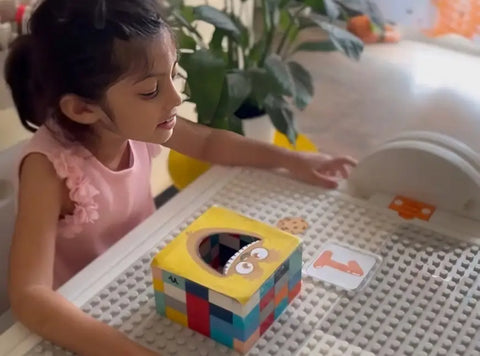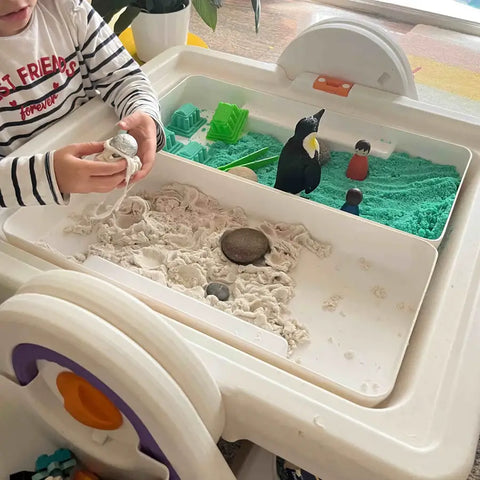

Developing Early Math Skills in Kids : Quantities First, Numbers Later
Developing Early Math Skills in Kids : Quantities First, Numbers Later
- By Sanaa Syed

Think about all the ways that numbers and counting are part of your child’s daily life! From counting the mangoes in the fruit basket to playing "ready-set-go!" in the park, you are perfectly positioned to observe and nurture the early math skills your 3- to 4-year-old is developing. Parents and educators want to help children learn numbers and counting using the Montessori method.
The Montessori approach offers a well-structured and child-friendly way to teach numbers and counting, matching a child's natural curiosity. As an expert in child development and Montessori practices, here’s a simple guide that I would suggest, to show you how to teach numbers and counting the Montessori way. The tips and activities that follow will help you understand what math awareness and skills your child should be acquiring and how you can support their development.
Counting One by One: Building Sensorial Impressions
When children begin counting one by one, they are not just learning to recite numbers but are developing a sensory understanding of quantity. For instance, using number rods or grouping objects during play helps them visually and physically grasp the idea of increasing amounts. Each count provides a tangible impression of what "more" looks and feels like, setting a strong foundation for later abstract thinking.
Establishing Connections Between Numbers
Through hands-on activities, children start to see the relationships between numbers. For example, they might notice that adding one more block to a group of three makes four. This concrete experience of connecting numbers aids in understanding more complex mathematical concepts later on. By physically manipulating objects, children see and feel the incremental increase, which is far more impactful than just seeing numbers on a page.
Recognizing Groups: Little vs. Lot
Children naturally begin to recognize groups of items as being either "little" or "a lot." This recognition is essential for developing an understanding of quantity. When they see five apples versus one apple, they start to grasp the concept of quantity comparison. These early experiences are critical for building their ability to estimate and understand number magnitude, which are vital skills in math.
Building the Concept of More and Less
Understanding "more" and "less" is a fundamental part of early math education. Through play and exploration, children learn that adding to a group makes it more, and taking away makes it less. This foundational concept is crucial for later mathematical operations such as addition and subtraction. By engaging in activities that highlight these ideas, children develop a deeper understanding of numerical relationships.
Developing a Sensorial Idea of Addition
By manipulating physical objects, children can see firsthand how combining groups leads to a larger group. This sensorial experience of addition is far more meaningful than memorizing addition facts. For instance, when a child combines two sets of three blocks, they can see and feel that they now have six blocks. This concrete understanding of addition helps build a strong mathematical foundation.
The Montessori Method: Concrete to Abstract
The Montessori method emphasizes the progression from concrete experiences to abstract thinking. By starting with tangible objects and quantities, children develop a solid understanding of numbers and their relationships. Only after they have a firm grasp of these concrete experiences do they move on to abstract concepts like written numerals and symbols. This step-by-step approach ensures a deeper, more intuitive understanding of math.
Practical Activities for Teaching Quantity
Here are some practical activities that you can incorporate into your child's learning to teach the concept of quantity:
Sensory Bins/Play
Fill Miniture's Sensory Play Bin with various objects and encourage your child to count them.

Number Flash Cards
Use cards with dots or objects instead of numbers to reinforce the idea of quantity.
Dominoes
Play games with dominoes to teach counting and quantity recognition.
Abacus Play
Use an abacus to visually and physically move beads, reinforcing the concept of addition.
Verbal Counting
Count aloud during daily activities, such as climbing stairs or setting the table.
One-to-One Correspondence
Match objects with numbers to teach that each number corresponds to a specific quantity.
Cardinality
Reinforce that the last number counted represents the total quantity of objects.
Subitizing
Help your child recognize small quantities without counting, such as instantly recognizing three blocks without needing to count them one by one.
The Role of Number Sense
Developing number sense is about more than just counting. It's about having a good intuition about numbers and their relationships. This sense develops gradually through exploration and visualizing numbers in various contexts. Encouraging your child to think about numbers rather than just calculate helps them understand the relationships among numbers, fostering a deeper mathematical understanding.
Teaching children about quantity before introducing written numerals is a powerful way to build a strong foundation in early math. By focusing on concrete experiences and sensorial learning, children develop a deeper, more intuitive understanding of numbers and their relationships. This approach not only aligns with Montessori principles but also sets children up for success in more complex mathematical concepts later on.
By incorporating these methods into your child's learning, you are not only teaching them to count but also fostering a lifelong love and understanding of math. Remember, the goal is to make learning fun and meaningful, providing your child with the tools they need to succeed.
Incorporate these tips into your parenting and play school routines to create an enriching learning environment for your child. For more educational insights and high-quality play furniture that supports your child’s development, visit our blog and explore our offerings.






